Random lasers provide a fascinating window into fundamental physics and promise many useful practical applications.
Diederik S. Wiersma, European Laboratory for Non-linear Spectroscopy (LENS)
Anyone with optics experience knows that dust should be avoided as much as possible. It can contaminate optical surfaces, degrading performance and, sometimes — on the output facet of a diode laser, for example — cause disastrous optical damage. Although dust sometimes absorbs light, its chief sin is scattering light; that is, changing its propagation direction in a random fashion.
But it turns out that this same random scattering process — the nemesis of conventional lasers — can be harnessed to create a completely new type of laser, called a random laser. These unusual devices have drawn the interest of scientists recently, both because of their potential applications and because of the fascinating physics behind the random lasing process.
A high density of scattering particles forms an opaque material because light is scattered diffusively — that is, many times and in a random fashion. As the number of scattering events increases, the probability of light continuing in the original direction decreases. Dust particles are one example of scattering materials, but there are many others, including powders, white paint, dense fog and human skin.
You can observe light diffusion by shining a laser pointer on a sugar cube. The beam is scattered many times by the sugar particles and, eventually, emerges from the sugar cube in all directions. This diffusive light is not equally distributed in space, but a careful analysis reveals a grainy pattern known as laser speckle. An example of such a speckle pattern is shown in Figure 1.
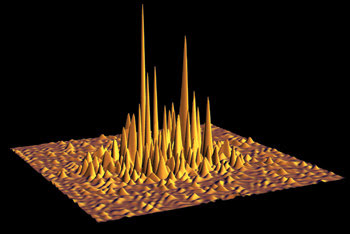
Figure 1. This example of a speckle pattern shows the intensity distribution pattern generated by the diffusion of light from a strongly scattering material. The height of the peaks represents the intensity of the light. One can see that, despite the random scattering, interference effects lead to very intense peaks as well as to points of zero intensity.
Observing interference
Although light diffusion is very common, the physics behind the phenomenon is complex and not particularly intuitive. One property that makes diffusive materials interesting is that the phase of the light waves is not lost in this process.1 This makes it possible to observe interference effects even in randomly scattering materials, such as the speckle pattern from a sugar bowl.
Another interesting observation is that diffusive scattering is reversible. If one collects all the diffusely scattered light from the sugar cube and sends it backward, a clean light beam will emerge from the cube and go back into the laser, as shown in Figure 2. This effect, called “reciprocity,” is the basis of many interesting physical phenomena in random systems.2-4
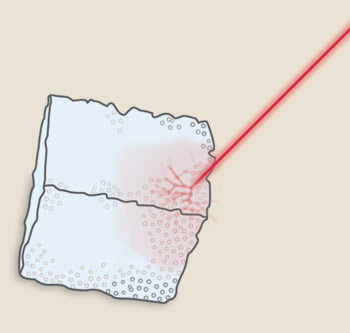
Figure 2. The incident light beam is scattered several times by the sugar grains. This multiple light scattering is an example of light diffusion. The grains form scattering elements that redirect the propagation direction of the laser light. The process is complex yet completely reversible. If all outgoing partial waves are reversed, a light beam is recovered and goes back into the laser.
The sugar cube experiment reveals that neither sugar, nor scattering particles in general, destroy the fundamental properties of light waves. And, most importantly, it tells us that light can remain coherent in a random system, thereby opening the possibility of making a laser from a diffusively scattering system.
The fundamental requirements for laser action are gain and feedback. Typically, gain is supplied by a population inversion, and feedback, by the laser resonator. A population inversion can be obtained easily enough in a random system by, for example, optically pumping a Ti:sapphire crystal that has been ground into a fine powder. The small grains of powder not only will scatter the light, but also amplify its intensity by stimulated emission. But how does one create feedback in a random system?
The essence of a random laser is that the multiple scattering process itself can be used to obtain feedback.5 It is the diffusive scattering that traps the light inside the sample long enough to obtain laser action, as indicated in Figure 3. This can be easily understood from the balance between gain and loss. The loss, formed by the light that escapes through the sample boundaries, is proportional to the sample surface. Total gain, on the other hand, is proportional to the volume of the sample.
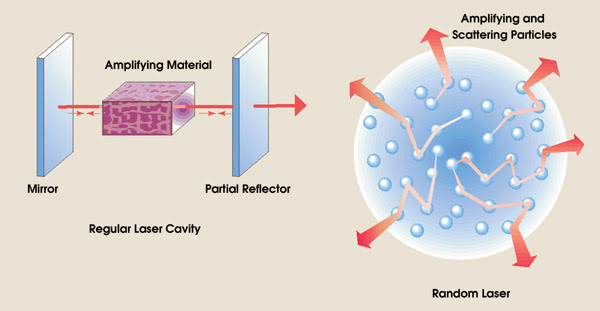
Figure 3. In a regular laser, the resonator provides the feedback necessary for the laser to reach threshold (left). In a random laser, the feedback is reached by light diffusion (right). The multiple scattering process retains the light inside the sample long enough to obtain an overall gain that is larger than the losses. Reprinted from Nature 406, 132-133 (2000).
Hence, there exists a critical volume above which gain becomes larger than loss and the system lases. The simplest form of random lasing — diffusive — has been observed in a variety of systems, including powders, colloidal suspensions and biological material.6-8
Random laser emission is characterized by spectral narrowing above the laser threshold and broad-angle emission. Also, the emission from a diffusive random laser maintains a surprisingly high level of coherence, despite the multiple scattering.9
Besides this diffusive form of random lasing, a more complex mechanism — in which interference dominates — can play a role. For interference to dominate requires extremely strong scattering, leading to the formation of randomly distributed standing waves inside the sample (Figure 4). This formation can be thought of as the optical counterpart of Anderson localization.10
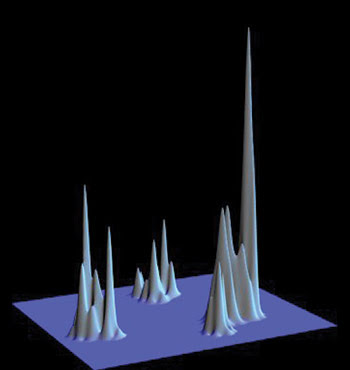
Figure 4. This plot shows the intensity distribution of light inside a strongly scattering material when Anderson localization takes place. The intensity is concentrated in highly confined regions because of interference. This effect is due to the formation of random standing waves. The localized modes theoretically could serve as laser cavities. Whereas diffusive random lasing has by now been realized in many materials, the combination of random lasing and Anderson localization has yet to be observed. Reprinted from Nature (Ref. 3).
Building a laser based on these localized waves in random systems has been the goal of several experimental studies recently,11 and although the studies have yielded some interesting physics,12,13 the laser itself has so far remained elusive. As yet, localization and lasing have not been demonstrated together on the same material, leaving a fascinating challenge for the research community.
The observation of diffusive random lasing, on the other hand, has inspired the photonics community to develop applications with this new type of light source.
The advantages of a random laser are that it is easy to fabricate and cheap, and it can distribute spectrally selective and reasonably coherent emission over a broad angular range. The production of random lasers — especially if done on a large scale — could be cheaper than that of LEDs. In addition, efficiency is much higher than that of a filament lamp, and its lifetime is expected to be long if prepared from the right materials.
Automotive lighting
Hence, these lasers could be used in lighting applications for the automotive industry or for environment lighting. A particular advantage of random laser materials is that they can be produced in the form of a coating that can be applied to arbitrarily shaped surfaces. This is possible because a random laser can consist of a suspension of microspheres or powders that provide the scattering elements together with the optical gain. Application of this coating to a surface will produce the properties of a random laser source and might one day allow the lighting to be painted onto the walls of a room or onto city streets.
Broad angular emission and color selectivity also are needed for active displays. In this application, the low manufacturing cost, combined with the flexibility to work with arbitrarily shaped surfaces, might allow low-cost active displays on such things as the packaging of consumer goods.
A less obvious, yet interesting, application of the random laser could be remote temperature sensing. It was recently demonstrated that a random laser can be realized in systems that consist of liquid crystal composites such as liquid crystal dye-infiltrated porous glasses and active polymer dispersed liquid crystals.14 The scattering strength of the liquid droplets will depend on their temperature, so that a laser could be designed to switch on or off at a specific temperature.
One might place a small amount of random lasing material in a hostile environment and infer the environment’s temperature by observing the emission characteristics from a distance. Likewise, random lasers might be used for monitoring biological processes that have to be stabilized around a certain critical temperature.
Random lasers based on polymer dispersed liquid crystals have the additional advantage that they can be controlled by an electric field. For this, the droplets are aligned in a certain direction when an electric field is applied and are randomly oriented otherwise. This allows switching of the emission of the random laser electrically, a key property for the development of displays.
While investigators were developing random laser materials for display applications, they happened upon some unexpected properties of the material that were highly interesting from a fundamental physics perspective: The huge anisotropy that the electric field introduced to the scattering process produced significant directionality from a random laser, resulting in a polarized, planar output instead of the usual omnidirectional emission expected from a random laser (Figure 5). The discovery led to a better understanding of anisotropic transport processes and anisotropic diffusion of light waves.
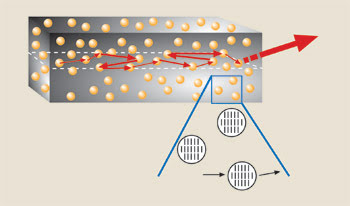
Figure 5. Diffusive random lasing is shown in polymer dispersed liquid crystals. The multiple scattering in these materials results from small droplets of liquid crystal (shown as orange spheres) incorporated in a polymer matrix. The droplets contain laser dye to achieve both scattering and optical gain. If an electric field is applied in the vertical direction, the liquid crystal molecules align along the field (shown in the zoom) and the scattering becomes highly anisotropic. This anisotropy is so strong that the buildup of laser emission during the multiple scattering (red arrows) takes place mainly in two directions. The output of this random laser thereby regains (planar) directionality and becomes polarized. The control of the random laser emission with an external electric field is important for applications in display technology, and the directional random emission turns out to have fascinating properties from a fundamental point of view. Reprinted with permission from Physical Review Letters (2004) Vol. 93, 263901.
Although it may seem a little premature to speculate on applications of random lasers based on Anderson localization — because the lasers themselves haven’t been demonstrated yet — there is at least one possibility so intriguing that it is painful not to mention it. Such a laser would have a series of sharp spectral peaks corresponding to its specific laser modes. Every arrangement of the random scattering elements would lead to a different collection of peaks, which would be unique for each specific sample.
This would open up interesting possibilities for coding of objects and documents with a hidden code that appears only when the random laser material is excited. A small droplet of random laser coating can be easily hidden because it has an opaque appearance, similar to that of a powder. When incorporated into a piece of paper or banknote, it could even be invisible until the random laser is excited.
These examples show that the interest in random lasers lies in both their applications and in the fundamental physics behind the lasing process. Whereas the research community can appreciate the beautiful physics related to transport processes in (active) random systems, photonics engineers have already started to explore the possibilities that these new light sources have to offer.
Meet the author
Diederik S. Wiersma is associate professor of the National Institute for the Physics of Matter (INFM) and group leader at the European Laboratory for Non-linear Spectroscopy (LENS) in Florence, Italy; e-mail: [email protected]
References
1. P. Sheng (1995). Introduction to wave scattering, localization, and mesoscopic phenomena. Academic Press, San Diego.
2. M.P.V. Albada and A. Lagendijk (1985). Observation of weak localization of light in a random medium. PHYS REV LETT, Vol. 55, pp. 2692-2695.
3. D.S. Wiersma et al (Dec. 18, 1997). Localization of light in a disordered medium. NATURE, pp. 671-673.
4. F. Scheffold and G. Maret (1998). Universal conductance fluctuations of light. PHYS REV LETT, Vol. 81, pp. 5800-5803.
5. D.S. Wiersma and A. Lagendijk (1996). Light diffusion with gain and random lasers. PHYS REV E, Vol. 54, pp. 4256-4265.
6. V.M. Markushev et al (1986). Powder laser. ZH PRIKL SPEKTROSK, Vol. 45, p. 847.
7. Jordi Martorell et al (1996). Radiative coupling between photonic paint layers. OPT LETT, Vol. 21, p. 239.
8. R.C. Polson and Z.V. Vardeny (2004). Random lasing in human tissues. APPL PHYS LETT, Vol. 85, pp.1289-1291.
9. L. Florescu and S. John (2004). Photon statistics and coherence in light emission from a random laser. PHYS REV LETT, Vol. 93, 013602.
10. P.W. Anderson (1985). The question of classical localization: A theory of white paint? PHIL MAG B, Vol. 52, p. 505.
11. H. Cao et al (1999). Random laser action in semiconductor powder. PHYS REV LETT, Vol. 82, pp. 2278-2281.
12. S.E. Skipetrov and B.A. van Tiggelen (2004). Dynamics of weakly localized waves. PHYS REV LETT, Vol. 92, 113901.
13. S. Mujumdar et al (2004). Amplified extended modes in random lasers. PHYS REV LETT, Vol. 93, 053903.
14. S. Gottardo et al (2004). Quasi-two-dimensional diffusive random laser action. PHYS REV LETT, Vol. 93, 263901.